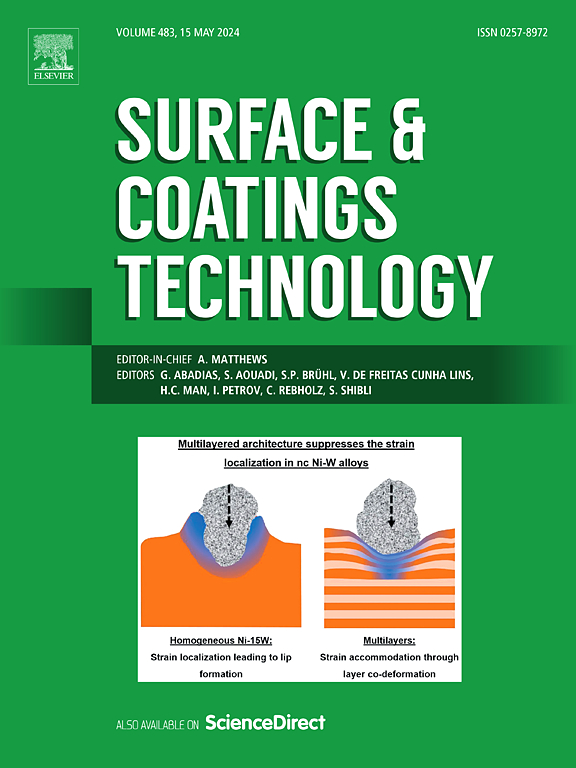环保型季铵改性PDMS涂料,具有抗菌、防藻、海洋防污等综合性能
IF 5.3
2区 材料科学
Q1 MATERIALS SCIENCE, COATINGS & FILMS
引用次数: 0
摘要
随着铜和增强型杀菌剂在防污涂料中的应用所带来的生态风险日益明显,环保型船舶防污涂料的设计和开发面临着新的挑战。在本研究中,我们开发了一种聚氨酯(PU)改性聚二甲基硅氧烷(PDMS)共聚物(PDMS-PU),然后使用四种不同碳链长度的溴化烷烃对共聚物进行季铵盐化。软段PDMS、硬段n -甲基二乙醇胺(MDEA)和异虫酮二异氰酸酯(IPDI),以及强交联氢键确保了PDMS- pu聚合物涂层具有增强的机械性能、良好的耐久性和静态抗藻性能。经季铵化处理后,涂层的抗菌和抗藻性能显著提高。改性后的涂层对金黄色葡萄球菌和大肠杆菌的抑菌率分别为99.1%,对小球藻和三角锥虫的抑藻率分别为88.9%和80.2%。抗藻机制包括膜电位增加,随后破裂,导致细胞损伤和DNA泄漏。此外,PDMS-PU-X涂层(其中X = 4,8,12,16,代表用于季铵盐化的溴烷烃中的碳原子数)对海洋微生物、液体污染物和伪附着物具有优异的防污性能。斑马鱼毒性实验进一步证实了该涂层对非靶生物的无毒性。本研究为开发环保型船舶防污涂料提供了新的思路。本文章由计算机程序翻译,如有差异,请以英文原文为准。

Eco-friendly quaternary ammonium modified PDMS coatings with integrated anti-bacterial, anti-algae, and marine anti-fouling properties
As the ecological risks associated with the use of copper and booster biocides in anti-fouling coatings become increasingly apparent, the design and development of environmentally friendly marine anti-fouling coatings present novel challenges. In this study, we developed a polyurethane (PU) modified polydimethylsiloxane (PDMS) copolymer (PDMS-PU) and then quaternized the copolymer using four brominated alkanes with varying carbon chain lengths. The soft segment PDMS, hard segments N-methyldiethanolamine (MDEA) and isophorone diisocyanate (IPDI), and strong cross-linked hydrogen bonds ensure the PDMS-PU polymer coatings with enhanced mechanical properties, good durability and static anti-algae properties. The quaternization of the coating resulted in a significant enhancement in its anti-bacterial and anti-algae performance. The modified coatings exhibited 99.1 % anti-bacterial inhibition against Staphylococcus aureus and Escherichia coli, and achieved 88.9 % and 80.2 % anti-algae inhibition rate for Chlorella and P. tricornutum, respectively. The anti-algae mechanism involves an increase in membrane potential followed by rupture, resulting in cellular damage and DNA leakage. In addition, the PDMS-PU-X coatings (where X = 4, 8, 12, 16, representing the number of carbon atoms in the bromoalkanes used for quaternization) demonstrated excellent anti-fouling performance against marine microorganisms, liquid pollutants, and pseudo-barnacle adhesion. The laboratory zebrafish toxicity tests further confirmed the coatings' non-toxicity toward non-target organisms. This study provides a novel strategy for developing environmentally friendly marine anti-fouling coatings.
求助全文
通过发布文献求助,成功后即可免费获取论文全文。
去求助
来源期刊

Surface & Coatings Technology
工程技术-材料科学:膜
CiteScore
10.00
自引率
11.10%
发文量
921
审稿时长
19 days
期刊介绍:
Surface and Coatings Technology is an international archival journal publishing scientific papers on significant developments in surface and interface engineering to modify and improve the surface properties of materials for protection in demanding contact conditions or aggressive environments, or for enhanced functional performance. Contributions range from original scientific articles concerned with fundamental and applied aspects of research or direct applications of metallic, inorganic, organic and composite coatings, to invited reviews of current technology in specific areas. Papers submitted to this journal are expected to be in line with the following aspects in processes, and properties/performance:
A. Processes: Physical and chemical vapour deposition techniques, thermal and plasma spraying, surface modification by directed energy techniques such as ion, electron and laser beams, thermo-chemical treatment, wet chemical and electrochemical processes such as plating, sol-gel coating, anodization, plasma electrolytic oxidation, etc., but excluding painting.
B. Properties/performance: friction performance, wear resistance (e.g., abrasion, erosion, fretting, etc), corrosion and oxidation resistance, thermal protection, diffusion resistance, hydrophilicity/hydrophobicity, and properties relevant to smart materials behaviour and enhanced multifunctional performance for environmental, energy and medical applications, but excluding device aspects.
 求助内容:
求助内容: 应助结果提醒方式:
应助结果提醒方式:


